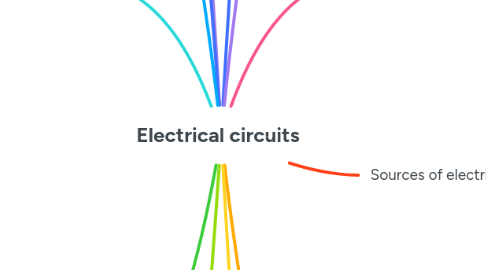
1. Input Waveforms (V,I,P)
2. Laws Goverring Linear Circuits
2.1. Ohm´s Law:
2.1.1. “When applying a voltage to a passive linear circuit, a current will flow through it, which depends directly on the applied voltaje and inversely on its resistance”.
2.2. Kirchhoff´s Laws:
2.2.1. A) Voltages Kirchoof´s Law (SVk)
2.2.2. B) Currents Kirchoof´s Law (SIk)
3. Conventional Flow
3.1. When leaving the source, electrons (I) have high energy level (+).
3.2. • When reaching the load, electrons deliver its energy.
3.3. Electrons leaves the load without energy (-).
3.4. Electrones return the source, the receive external energy.
4. Electric Process
4.1. Energy “x”
4.1.1. Generator
4.1.1.1. Electricity
4.2. Transmission Medium
4.2.1. Conductors
4.2.1.1. Wires
4.3. Transportation agent
4.3.1. Electrons
4.4. Electricity “Charge”
4.4.1. Energy "x"
4.4.2. The Eletric Process
4.4.2.1. The free elcetrons of a conductor moves through the atom’s conducción band randomly.
4.4.2.1.1. When It is applied a potencial difference, the free electrons, moves with direction and order.
5. Kirchhoff´s laws
5.1. Kirchoff´s Current Law
5.1.1. “The algebraic sum of the currents in the branches, ina any node of an electrical circuit is eqal to zero”.
5.2. To apply Kirchoff´s Law
5.2.1. it is necessary to know the directions of the branch current and voltaje arrows, according to the conventional sense of polarities assigned to branch terminals.
5.3. Kirchoff´s Voltage Law
5.3.1. “La suma algebraica de los voltajes de rama en cualquier lazo de un circuito es igual a cero”.
5.4. ”The algebraic sum of the branch voltajes in any closed loop of a circuit is equal to zero”.
5.5. The application procedure is the following
5.5.1. Knwing the branch voltaje arrows and identyfing the loops, the loop is traversed in any direction considering the voltaje arrows of the positive branches in favor of the path and negative against the path
6. Transducer
6.1. A) Active Electric Transducers (Sources):
6.1.1. They recieve any kind of energy
6.1.2. They deliver or feed the electric system
6.1.3. They are sources of electric energy
6.2. B) Pasive Electric Transducer (Loads):
6.2.1. They consume electric energy
6.2.2. They deliver other energy form
7. Atomic Theory
7.1. Molecules
7.1.1. They are compossed by atoms
7.2. Nucleus
7.2.1. NEUTRON: small charge, many mass
7.2.1.1. Atomic Estabiliy
7.2.1.1.1. It has the valence shell complete.
7.2.1.1.2. 3 cases of the number of valence electrons
7.2.1.2. POSITRON: big charge, small mass
8. Energy shells
8.1. Valence Band
8.1.1. Is the outermost electron orbitalof an atom of any specific material that electrons actually occupy.
8.2. Band Gap
8.2.1. Is the energy differnce between the highest occupied enetgy state of the valence band and the lowest unoccupied state of the conduction band.
8.3. Conduction Band
8.3.1. Is the band of electron orbitals that electrons can jump up into the valence band when excited.
8.4. Valence Electron
8.4.1. They are loccated in the outermost shell af an atom
8.5. Free Electron
8.5.1. They are ot bounded to the nucleus, they can move anywhere inside the crystal.
9. Resistance
9.1. It is the force which retains the valence electrons within the atoms nucleus to avoid
9.1.1. CURRENT (I) it is measured in amperes
9.1.2. ELECTROMOTIVE FORCE (EMF) it is measured in volts
9.1.3. ELECTRIC RESISTANCE (R) it is measured in ohms
10. Sources of electric power
10.1. They deliver to the loads: voltage, or current.
10.1.1. Types of sources
10.1.1.1. A) Voltage Source: is a two-terminal devine which can maintain a fixed voltage, of the load change
10.1.1.2. B) Current Source: is a two-terminal devine which can maintain a fixed current, of the load change
11. Input Waveforms (V,I,P)
11.1. A) Continuous signal
11.2. B) Direct Signal: ✴ VARIABLE MAGNITUDE. ✴ FIXED POLARITY. ✴ VARIABLE MAGNITUDE. ✴ VARIABLE POLARITY. ✴ NO SIMETRY OR PERIOD.
11.2.1. ✴ VARIABLE MAGNITUDE. ✴ FIXED POLARITY. ✴ VARIABLE MAGNITUDE. ✴ VARIABLE POLARITY. ✴ NO SIMETRY OR PERIOD.
11.2.2. ✴ FIXED POLARITY. ✴ VARIABLE MAGNITUDE. ✴ VARIABLE POLARITY. ✴ NO SIMETRY OR PERIOD.
11.3. C) Discrete Signal
11.4. D) Alterning sigmal:
11.4.1. (SINE, TRIANGULAR SQUARE WAVE).
11.4.2. VARIABLE MAGNITUDE.
11.4.3. VARIABLE POLARITY
